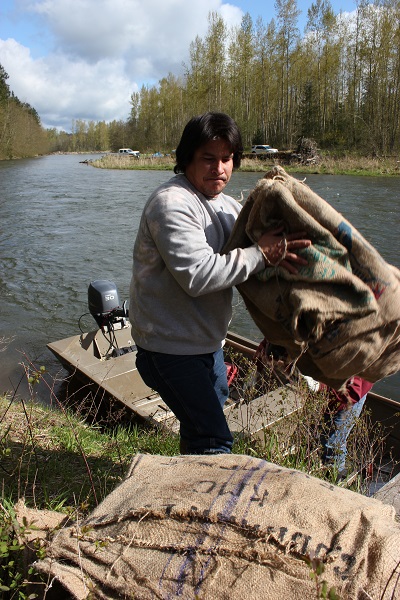By John Dodge, The Olympian
Pink salmon, Puget Sound’s smallest, most short-lived and most abundant of five native salmon species, are returning in record numbers to the Nisqually River.
There are so many of these 3- to 7-pound fish stacking up in the river, it conjures up the old saying: “They’re so thick, you could walk across the river on their backs.”
They aren’t quite that thick, but they are pulsing upstream to spawn in numbers that boggle the mind. More than 700,000 pinks are expected to enter the river this year out of an estimated Puget Sound run size of 6.2 million fish.
Flash back 10 years and tribal biologists were hard-pressed to find pink salmon in the river at all.
What gives? The first phrase out of the mouths of fish biologists is: “good ocean survival.” But that’s a catch-all phrase that might not tell the whole story.
A little more about a pink salmon’s life history: A pink salmon migrates to saltwater shortly after it emerges from the gravel as a fry salmon. They quickly make their way through Puget Sound to ocean waters.
They live only two years, returning to spawn in odd-numbered years. By comparison, the four other species of Pacific Northwest native salmon – chinook, coho, sockeye and chum – live three years or more in fresh and salt water.
So pink salmon live the simplest of lives – less time exposed to pollution, predators and harvesters.
And they eat pretty low on the food chain. Their diets consist of things like zooplankton and small, abundant marine crustaceans, said tribal salmon-enhancement manager Bill St. Jean.
So while marine scientists puzzle about why the more prized salmon such as coho and chinook experience disturbingly low survival rates in Puget Sound, the pink salmon seem to be growing in abundance and geographic reach.
“Their ocean survival has been phenomenal, but their simple life history may be playing a role in the increase,” Nisqually tribal natural resources manager David Troutt said. “Meanwhile the more complex species in Puget Sound are struggling. It’s a potential indicator that Puget Sound is becoming a simpler ecosystem, which should be a source of concern.”
While Nisqually sport and tribal fishers are taking a small share of the large pink run, the vast majority of the fish are being passed upstream to spawn. A tribal fish weir was installed in the river primarily to sort through chinook salmon to keep hatchery chinook from swimming upstream to interfere with naturally spawning chinook. But it has been dominated by pink salmon the past two weeks.
“We’re passing 200-plus pinks upstream every 10-20 minutes,” said Tom Friedrich, an intern with the Nisqually River Foundation, and part of the crew working at the fish weir near the tank crossing on Joint Base Lewis-McChord.
An occasional chinook salmon is found mingling with the pinks. However, it appears the chinook are waiting for the pinks to move upstream first, Troutt said.
The chinook might have to wait. As of Wednesday morning, more than 90,000 pinks had passed upstream, and they show no sign of letting up.
The 2013 pink run on the Nisqually is the source of extra work at the in-river fish trap, but no one seems to complain.
“It’s a lot of work, but it’s really fun to see all these fish,” St. Jean said, pointing at the mature male pinks distinguished by their humped backs, thus the nickname humpy.
The pink salmon, which die in the river shortly after spawning, are also returning valuable marine nutrients to the river watershed.
“I think we’re all glad to see the increased numbers of pink salmon,” said Lance Winecka, executive director of the South Sound Salmon Enhancement Group, a nonprofit working on habitat restoration projects. “They are a source of marine nutrients that South Sound river systems have been short on for several decades.”
In addition, the pink fry moving out of the river into saltwater in the spring provide food for young coho salmon, Troutt said.
Roy Wells, a tribal fish commissioner with a long history around the river, said he can’t remember seeing healthy pink salmon runs on the Nisqually since the 1970s. Tribal elders talk about prolific runs 60-70 years ago, St. Jean said.
“My mom used to fry them up – they’re good to eat,” Wells said. But first, she would trim the hump off the backs of males because they are full of fat, Wells said.
Wells on Tuesday hauled about 400 pounds of pink salmon to a cannery on Yelm Highway operated by Faith Harvest Helpers, a faith-based nonprofit that cans pink salmon for shipment overseas with other food and medical supplies to disaster-stricken countries,
“We hope to do a whole lot of pinks this year,” said Richard Norton, the faith group’s vice president.
Troutt said tribal officials are starting to talk about new ways to utilize pinks if they keep coming back in big numbers every other year.
Caviar anyone?



